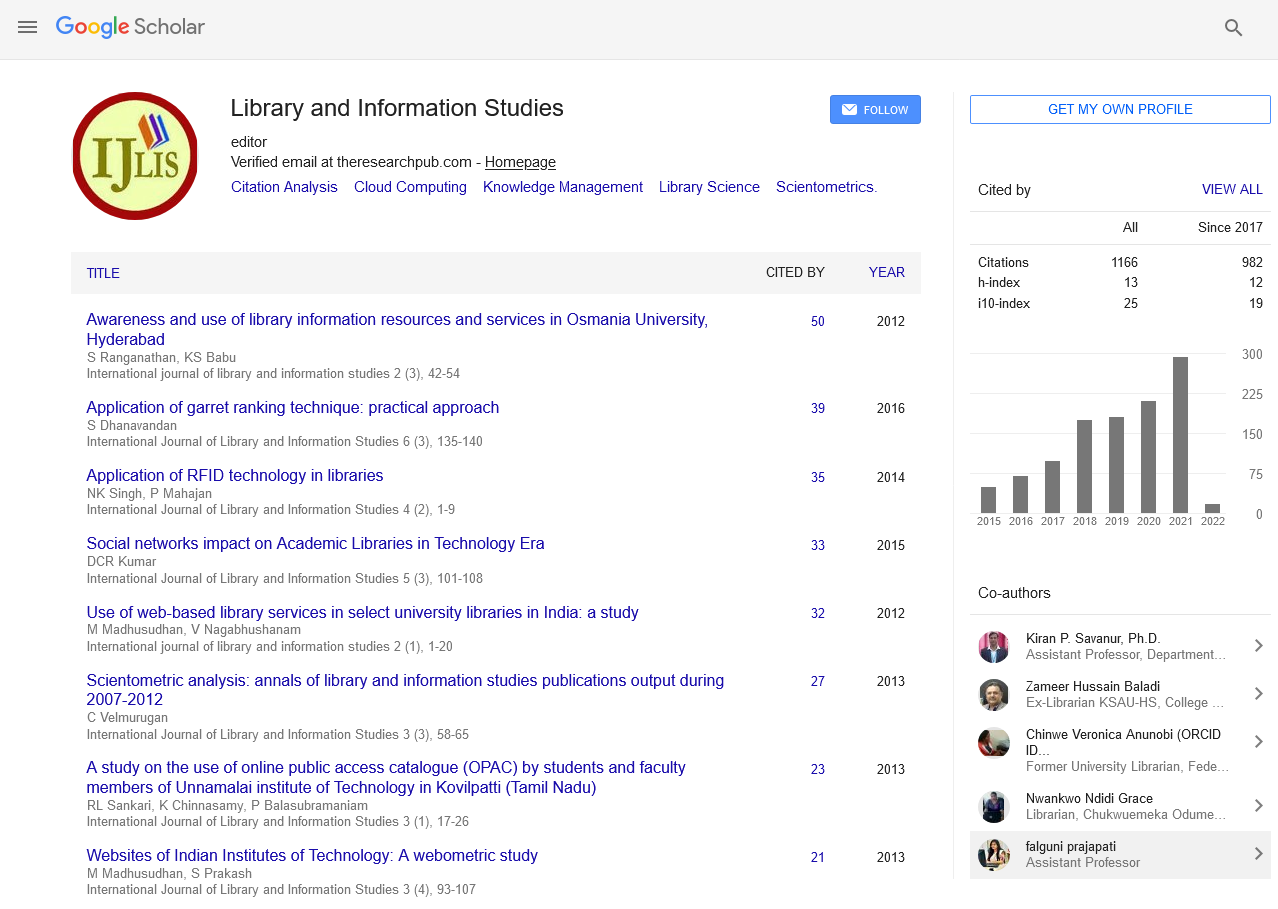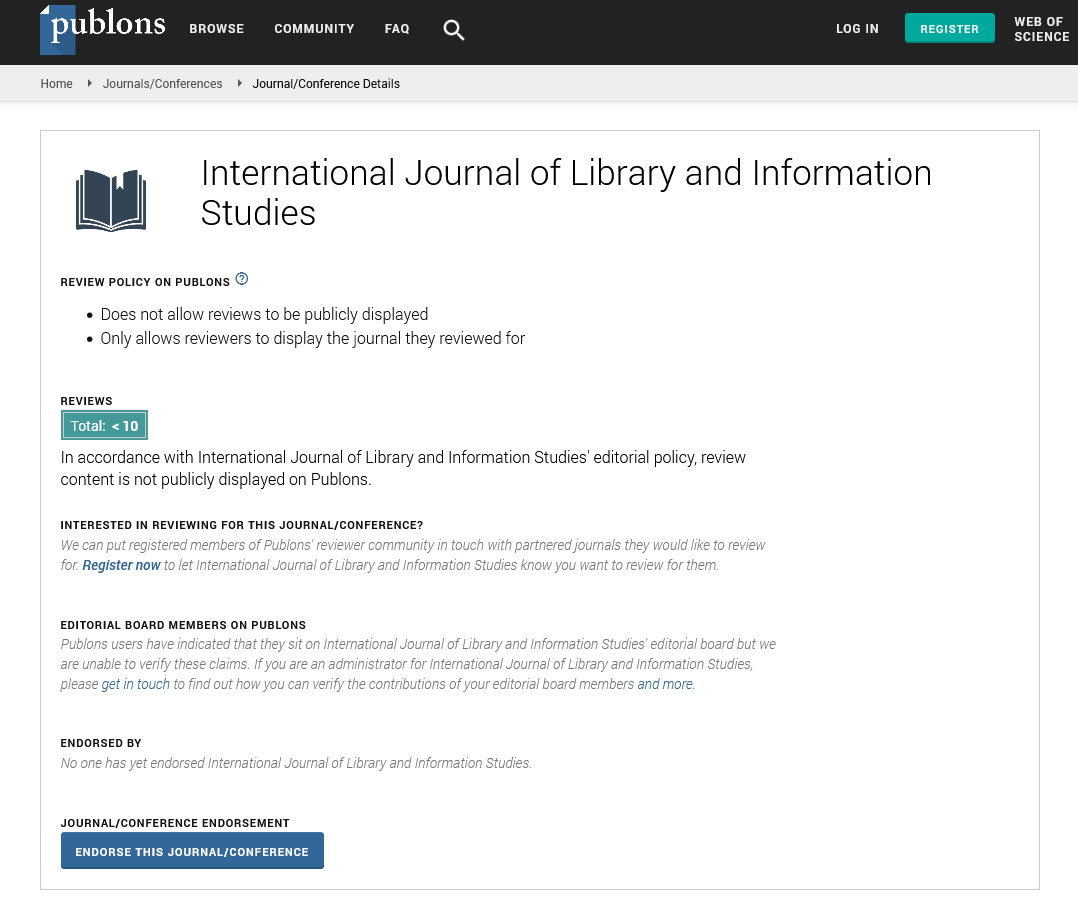Research Article - (2023) Volume 13, Issue 1
A Digital Library and Repositories Services of Universities in West Bengal State
Sukanta Jana*Abstract
The paper deals with the digital library and repositories services in top twelve universities in West Bengal state, which are existing today. The purpose of this research is to identify digital libraries initiative and repositories of West Bengal universities available in the public domain. The digital libraries initiative and repositories were identified through a study of the literature, as well as internet searching and browsing. The resulting digital libraries and repositories were explored to study their collections. Use of open source software especially for the creation of institutional repositories is found to be common. The digital revolution of the past two decades has transformed many conventional libraries in to digital libraries in the West Bengal state. The initial initiative of digital library and repository in West Bengal State started mainly for the preservation of academic related information, journal, thesis etc.
Keywords
Digital library, Repositories, University, D-space, West Bengal
Introduction
A digital libraries is a special library with a focused collection of digital objects that can include text, visual materials, audio materials, video materials, stored as electronic media formats. Digital libraries can very extremely in size and scope and can be maintained by individuals, organization or affiliated with established physical library building or institutions, or with academic institutions. The digital content may be stored locally, or accessed remotely via computer networks. Many academic libraries are actively involved in building institutional repositories of the institution’s books, papers, these and other works which can be digitized or were “born digital”. Many of these repositories are made available to the general public with few restrictions, in accordance with the goal of open access, in contrast to the publication of research in commercial journal, where the publishers often limit access right. Instructional, truly free and corporate repositories are sometimes referred to as digital libraries [1].
What is digital library?
A digital library is a collection of documents in organized electronic form, available on the internet or on CD-ROM (Compact Disk-Read only Memory) disks. Depending on the specific library, a user may be able to access magazine article, books, paper, images, sound file and videos etc.
Objectives of the study
• Access to large amount of information to users wherever they are needs it.
• Access to primary information sources.
• Network accessibility on intranet and internet.
• User friendly interface.
• Advanced search and retrieval.
Advantage of a digital library initiative and repository
• Nearly unlimited storage space at a much lower cost.
• Re-allocate funds from some staff, collection maintenance and additional books.
• No physical boundary.
• Round the clock availability.
• Multiple access and universal accessibility.
• Enhances information retrieval.
• Preservation for some print materials and institutional repository.
Hypothesis
• Majority of the university libraries have implemented digital library initiative in the library.
• The e-resources and institution repositories are used by the teacher and students of the university libraries.
Materials and Methods
The study is focused on the top 12 universities in the west Bengal state. The digital library initiative and repositories of universities in West Bengal state were identified from the internet and universities website. After the collection of data, it was subjected to analysis by using MS-Excel and interpreted in the form of numbers and percentages in tabular form [2].
Data collection and analysis
For this study top most 12 universities in West Bengal state were surveyed with the help of universities librarian and staff and also universities website. The collected information on the use of digital library and institutional repositories and E-resources in the universities library are presented here through tabular and graphical form [3]. I am chosen top 12 university in West Bengal state namely Visva-Bharati University, Kazi Nazrul university, university of Burdwan, university of Calcutta, Jadavpur university, university of Kalyani, Presidency university, Rabindra Bharati University, West Bengal State university, Vidyasagar university, university of North Bengal and Bankura University (Table 1).
| Software | No of Libraries | Percentage |
|---|---|---|
| KOHA | 7 | 58% |
| SOUL | 3 | 25% |
| LIBSYS | 2 | 17% |
| DSPACE | 12 | 100% |
Table 1: Software in the libraries.
Use of automation software in the libraries
The Table shows that, 58% of universities libraries are using KOHA out of 12 universities and 25% of universities libraries are using SOUL, 17% are using LIBSYS and 100% are using D-space as institutional repository software (Table 2) (Figure 1).
| Mode of circulation | No of libraries | Percentage |
|---|---|---|
| Manual | 0 | 0% |
| Automated | 10 | 83% |
| Both | 2 | 17% |
| Total | 12 | 100% |
Table 2: Mode of circulation.
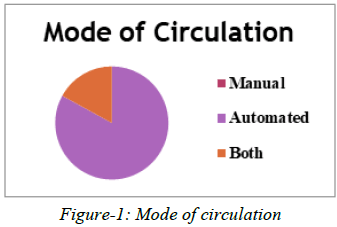
Figure 1: Mode of circulation
The Table shows 83% of universities libraries are still using automated process of circulation, and 17% of libraries are maintaining both manual and automated system side by side i.e. Kazi Nazrul University, Bankura University (Table 3).
| Name of the tools | No of libraries | Percentage |
|---|---|---|
| Printer | 12 | 100% |
| Scanner | 12 | 100% |
| Barcode reader | 9 | 75% |
| Photocopier | 12 | 100% |
| Projector | 8 | 67% |
| Internet cum Wi-Fi | 8 | 67% |
Table 3: Tools used for initiative of digital library and institutional repository based services.
The above Table shows that 100% of universities have printer, scanner and photocopy machines 75% have barcode reader, 67% have projector and internet cum Wi-Fi tools in use to digital library and institutional repository based services (Table 4).
| Promotional activities | No of libraries | Percentage |
|---|---|---|
| SMS alert | 8 | 67% |
| 7 | 58% | |
| Newsletter | 10 | 83% |
| Notice board | 12 | 100% |
| Library website | 8 | 67% |
| WhatsApp group | 0 | 0% |
| Social networking sites | 6 | 50% |
Table 4: Promotional activities.
The promotional activities of library like current awareness services, bibliographic services have become easier to render through the SMS, e-mail, social networking sites, library websites and in many other ways [4,5]. From the above table is found that 67% of universities libraries are using SMS alert and library web site, 58% are using e-mail, 83% are using newsletter, 100% are using notice board and 50% are using other social networking sites for promotional activities of universities library collections and services (Table 5).
| E-resource | No of libraries | Percentage |
|---|---|---|
| NDL | 9 | 75% |
| N-List | 11 | 92% |
| E-pathShala, Vidyamitra | 12 | 100% |
| NPTEL | 9 | 75% |
| SWAYAM | 8 | 67% |
| Other (DOAJ,E-Gayankosh) | 9 | 75% |
Table 5: Types of e-resources subscribed by the library.
Table 5, shows that 75% of universities libraries have taken membership in the national digital library of India to avail of e-resources freely and 92% universities libraries have N-list programme as e-resource for their users and 100% universities libraries have E-Pathshala, Vidyamitra as e-resources for their users [6-10].
I am showing the front page two central libraries of universities libraries (Figures 2 and 3).
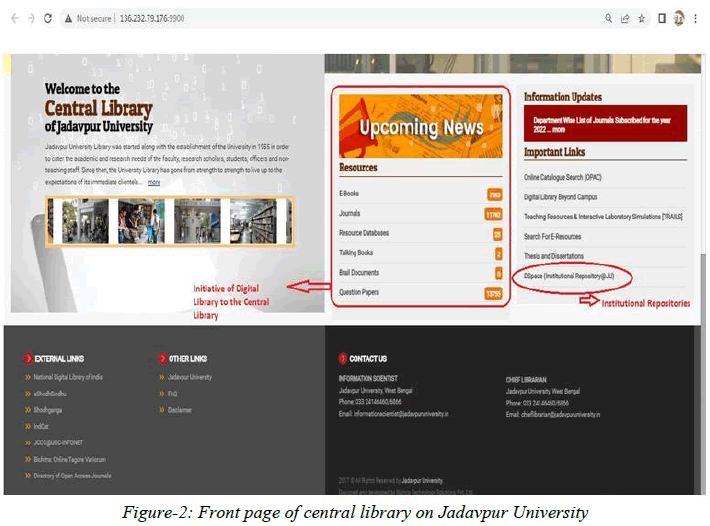
Figure 2: Front page of central library on Jadavpur University
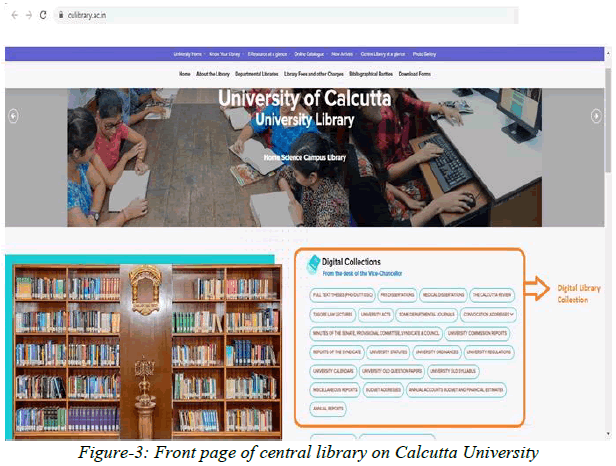
Figure 3: Front page of central library on Calcutta University
Results and Discussion
Findings
Majority of the universities are shifting their services from manual to fully automate and 58 % universities library are using KOHA as automation software. But, 17% of universities libraries are still using manual and automated process of circulation. Digital library software d-space is used for institutional repository in 100% universities library.
Among the 12 universities, presently 11 universities library are subscribing the N-list programme and only 9 universities are using NDL, NPTEL and DOAJ, E-Gayankosh in India use for their users.
Conclusion
Digital library and institutional repository resource centers have the chance to become powerful education support environment favorable to the proliferation of digital competences.
Digital library and institutional repository resource centers is as a practical and effective digitalization promoting strategy that contributes to the rapid improvement of digital skill and technology enhanced research expertise of all research agents like researcher, University teachers and Students and their close academic environment.
References
- Bhatnagar, J. “Use of ICT applications by students, faculty members and academic staff in ITM group of institutions’ Gwalior, India: A statistical survey.” International Journal of Computing, Communication and Networking 2.4 (2013):117-121.
- Biswas, A. “Branding and promoting college libraries under West Bengal state university through websites: A study.” College Libraries 34.2 (2019):15-27.
- Chitra, K. S., and Mallinath, K. “ICT infrastructure and automation in first grade college libraries affiliated to university of Mysore: A study.” International Journal of Library and Information Studies 10.2 (2020):156-166.
- Das, S. “Collection development of E-resources in university libraries of West Bengal: A comparative study.” International Journal for Research in Emerging Science and Technology 2.7 (2015):78-86.
- Wells, D., and Sallenbach, A. “Books and e-books in an academic library.” The Australian Library Journal 64.3 (2015):168-179.
- Shelburne, W, A. “E-book usage in an academic library: User attitudes and behaviors.” Library Collections, Acquisitions and Technical Services 33 (2009):59-72.
- Wilson, M, K. “Comparing print and e-book usage to meet patron needs.” Collection Management 46.2 (2021): 91-106.
- Bunkell, J., and Dyas-Correia, S. “E-Books vs. Print: Which is the better value?” The Serials Librarian 56.1 (2009): 215-219.
- Yuan, W., Ballegooie, M, V., and Jennifer, L. “Robertson E-books versus print books: Format preferences in an academic library”. Collection Management 43.1 (2018):28-48.
- Pandey, S, K. “Impact of e-books in academic libraries.” International Journal of Research in Library Science 2.1 (2016):151-154.
Author Info
Sukanta Jana*Received: 18-Feb-2023, Manuscript No. IJLIS-23-89625; Editor assigned: 20-Feb-2023, Pre QC No. IJLIS-23-89625 (PQ); Reviewed: 06-Mar-2023, QC No. IJLIS-23-89625; Revised: 20-Apr-2023, Manuscript No. IJLIS-23-89625 (R); Published: 27-Apr-2023, DOI: 10.35248/2231-4911.23.13.843
Copyright: This is an open access article distributed under the terms of the Creative Commons Attribution License, which permits unrestricted use, distribution, and reproduction in any medium, provided the original work is properly cited.
Call for Papers
Authors can contribute papers on
What is Your ORCID
Register for the persistent digital identifier that distinguishes you from every other researcher.
Social Bookmarking
Know Your Citation Style
American Psychological Association (APA)
Modern Language Association (MLA)
American Anthropological Association (AAA)
Society for American Archaeology
American Antiquity Citation Style
American Medical Association (AMA)
American Political Science Association(APSA)



